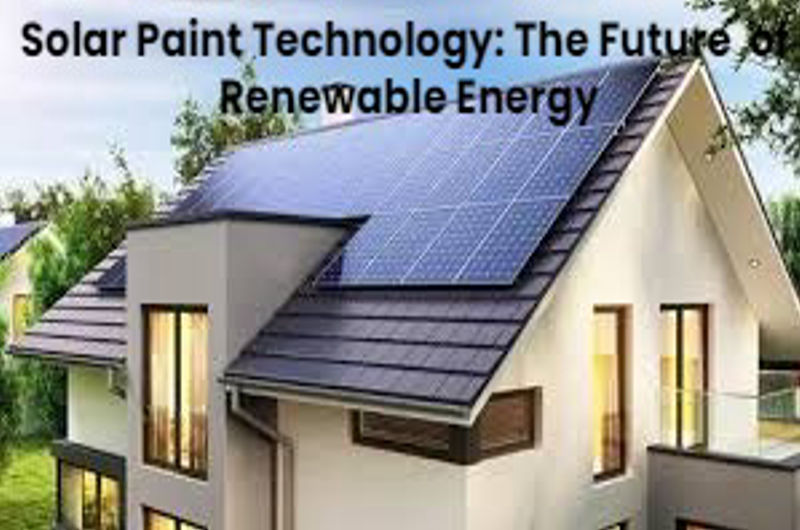Introduction
As the world shifts toward sustainable energy solutions, scientists are exploring innovative ways to harness solar power beyond traditional photovoltaic (PV) panels. One of the most exciting breakthroughs in this field is solar paint technology—a revolutionary concept that could turn virtually any surface into a solar energy generator.
But what exactly is solar paint, how does it work, and could it really replace conventional solar panels? In this in-depth article, we’ll explore:
–What solar paint is and how it functions
–A wide variety of solar panel types are being developed.
–Potential benefits and challenges
–Current advancements and future prospects
–How it compares to traditional solar panels
By the end, you’ll understand whether solar paint could be the next big thing in renewable energy.
What Is Solar Paint?
Solar paint, sometimes referred to as photovoltaic paint or sunshine-harvesting paint, is a liquid coating that contains light-sensitive substances that, when exposed to sunlight, can produce electricity.Unlike bulky solar panels, this paint can be applied to walls, roofs, cars, and even windows—transforming ordinary surfaces into power-generating assets.
How Does Solar Paint Work?
Solar paint contains tiny light-absorbing particles, such as:
Perovskite crystals – Highly efficient at converting sunlight into electricity.
Quantum dots are semiconductors at the nanoscale that absorb solar radiation.
Hydrogen-producing compounds – Some paints split water molecules to produce clean hydrogen fuel.
When sunlight hits the painted surface, these materials cause electrons to be activated, creating an electric current. After then, the energy can either be sent to the electrical grid or stored in batteries.
Types of Solar Paint in Development
Researchers are working on several variations of solar paint, each with unique properties:
1. Perovskite Solar Paint
Made from perovskite, a mineral-structured compound.
Efficiency: Over 25% in lab tests (close to silicon solar panels).
Advantage: Cheaper and easier to manufacture than traditional PV cells.
Challenge: Degrades faster when exposed to moisture and heat.
2. Quantum Dot Solar Paint
Uses nanoparticles called quantum dots (e.g., cadmium selenide).
Efficiency: Around 11% but improving.
Advantage: Can be tuned to absorb different light wavelengths.
Challenge: Some materials (like cadmium) are toxic.
3. Hydrogen-Producing Solar Paint
Contains molybdenum sulfide or titanium oxide.
Function: Absorbs sunlight and moisture to produce hydrogen fuel.
Possibility: Could supply renewable energy storage using hydrogen fuel cells.
Solar Paint’s Benefits Over Conventional Solar Panels
Feature Solar Paint Traditional Solar Panels
Installation Easy to apply (spray or brush) Requires mounting structures
Cost Potentially cheaper High manufacturing costs
Flexibility Can coat any surface Rigid and bulky
Aesthetics Blends seamlessly Visible panels may not suit all buildings
Weight Lightweight Heavy, needing strong support
Key Benefits:
✔ No Space Constraints – Paint can be applied to cars, windows, and curved surfaces.
✔ Lower Production Costs – Avoids expensive silicon used in PV panels.
✔ Scalability: Able to swiftly cover vast regions.
✔ Eco-Friendly – Some versions use non-toxic, abundant materials.
Challenges and Limitations
Despite its promise, solar paint faces hurdles:
Lower Efficiency – Most prototypes convert 5-15% of sunlight vs. 20%+ for silicon panels.
Durability Issues – Degrades faster due to moisture, UV exposure, and oxidation.
Toxicity Concerns – Some quantum dots contain hazardous materials like lead or cadmium.
Energy Storage – Requires efficient batteries or hydrogen storage systems.
Commercial Viability – Still in the R&D phase; mass production is years away.
Latest Breakthroughs in Solar Paint Technology
1. Self-Healing Perovskite Paint (2023 Study)
Scientists added protective polymers to prevent degradation.
Extended lifespan by 30% in lab tests.
2. Spray-On Solar Cells (University of Sheffield, 2022)
Formed a method for coating surface using perovskite solar paint.
Might make it possible to build massive solar farms on unusual surfaces.
3. Solar Paint That Generates Hydrogen (RMIT University, 2021)
Solar hydrogen paint is engineered to absorb atmospheric moisture.
Produces clean hydrogen fuel without electrolysis.
Future Prospects: When Will Solar Paint Be Available?
Experts predict:
2025-2030: First commercial applications (e.g., solar-coated windows).
2030+: Broad adoption expected if advancements in efficiency and durability continue.
Potential future uses:
🚗 Solar-powered electric cars – Paint-coated roofs charging batteries.
🏢 Energy-generating skyscrapers – Entire buildings acting as solar farms.
🌍 Off-grid energy solutions – Affordable solar paint for rural areas.
Conclusion: Will Solar Paint Replace Solar Panels?
While solar paint won’t replace traditional PV panels soon, it could complement them by turning unused surfaces into energy harvesters. If scientists overcome efficiency and durability challenges, solar paint might revolutionize how we generate clean energy—making solar power cheaper, more versatile, and accessible worldwide.


